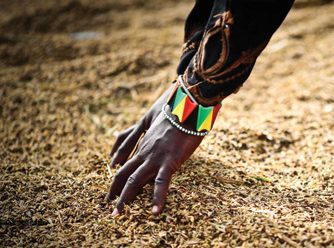
In the Vihiga district of western Kenya, farms average little more than an acre. Corn is the dominant crop and source of sustenance, but most households run short six to 10 months of the year. They supplement with beans, groundnuts, bananas and vegetables and make money by selling milk, if they are lucky enough to own a cow. Throughout the country, corn production is declining, and researchers are urgently searching for drought-tolerant varieties to meet the needs of a growing population. For people already on the edge, adapting to climate change is a life-and-death matter.
In fact, scientists say, projections of a warmer, drier climate in East Africa could cut food production as it is currently practiced on 82 percent of the farms in Vihiga. This rural area doesn’t have far to fall. More than half of its farm households already earn less than $1 per person per day.
John Antle sees a better future for the people of Vihiga. By shifting from corn to more drought-tolerant crops such as sweet potatoes, farmers could offset much if not all of the negative impacts of climate change. Moreover, since sweet potatoes are high in vitamin A and the vines make good livestock fodder, they could improve nutrition for their families, feed their cattle and maintain milk production.

Climate economics
John Antle received his Ph.D. from the University of Chicago in 1980. He is a University Fellow at Resources for the Future in Washington, D.C., and served as a senior staff economist for the President’s Council of Economic Advisers in 1989-90. He was a lead and contributing author of the third and fourth climate change assessments published by the Intergovernmental Panel on Climate Change (IPCC). As a co-leader of the economics team of the Agricultural Model Inter-Comparison and Improvement Project, he is working to characterize the risk of global hunger due to climate change and to enhance adaptation in developing and developed countries.
For the Oregon State University professor of Agricultural and Resource Economics (AREc), Vihiga demonstrates the need for climate-change adaptation policies. “Until now, adaptation has been politically incorrect in the climate world,” he says. “We see more and more evidence that real changes are happening, and we had better start thinking more about adapting.”
With a grant from the German international development agency GTZ, Antle and a research team from Wageningen University in the Netherlands and international research centers are evaluating the impacts of climate change on agriculture and the potential benefits of alternative cropping systems in East Africa. The simulation models that Antle and collaborators have developed over the past two decades are now being used by researchers globally to assess impacts of climate and other environmental changes in agriculture.
In the Great Plains and Midwest, he and co-author Susan Capalbo, head of AREc, have used these tools to study the potential for cropland to store carbon under conservation and reduced tillage systems. They are partnering with colleagues at OSU, Washington State, the University of Idaho and the U.S. Department of Agriculture to evaluate wheat in the Pacific Northwest under a changing climate (see “Against the Grain“).
Global Food Supplies
“For about a 150 years, the real price of wheat has gone down,” Antle says, even as global population has risen. “So why is that? Because supply has gone up faster than demand. That is the Green Revolution story, the scientific revolution that began after World War II and allowed agriculture to expand production. So the big question is, Are we now at a turning point where that’s no longer going to be true?”
Two factors — increasing demand from larger, more affluent populations; flattening growth in food supplies, as the Green Revolution bumps into production limits — are contributing to higher food prices. In the short term, he adds, there is still plenty of arable land available, and farmers can shift crops from fiber and fuel to food. But rising incomes in developing countries are already adding to demand and are likely to continue to do so well into the future.
He points to China, which, despite increasing incomes for a portion of its people, still has massive poverty. “People think that China is now this rich country. That’s wrong. There’s a small proportion of people in China who are well-off now, but if you get away from the coast, there are still a billion really, really poor people. That’s true for India and sub-Saharan Africa too.”
Those countries will continue to transition to a higher standard of living, he says. “For a long time, people have said, when the rest of the world tries to have a lifestyle like ours, we’ll be in trouble. Well, that’s what’s happening.”
On top of that, climate change poses an additional threat. Somalia and other parts of East Africa are already in their 16th year of drought. In Kenya, which hosts refugees fleeing violence and famine in Somalia, crop failures are common, and the country has to import corn to meet growing demand.
In their research, Antle and his colleagues combined available data on farm production in two Kenyan districts — Vihiga and Machakos — with the results of two climate models to estimate how new sweet potato varieties, milk, livestock and drought-tolerant corn might maintain food production and farm incomes in the future. Most previous studies of climate adaptation apply to large regions, such as whole countries. Their study was one of the first to compare the potential consequences of several climate change adaptation strategies for agriculture with this much detail.
“We’re trying to understand these systems, what characteristics make them work better or worse and what kinds of crop-breeding activities would work with changes in climate,” says Antle.
